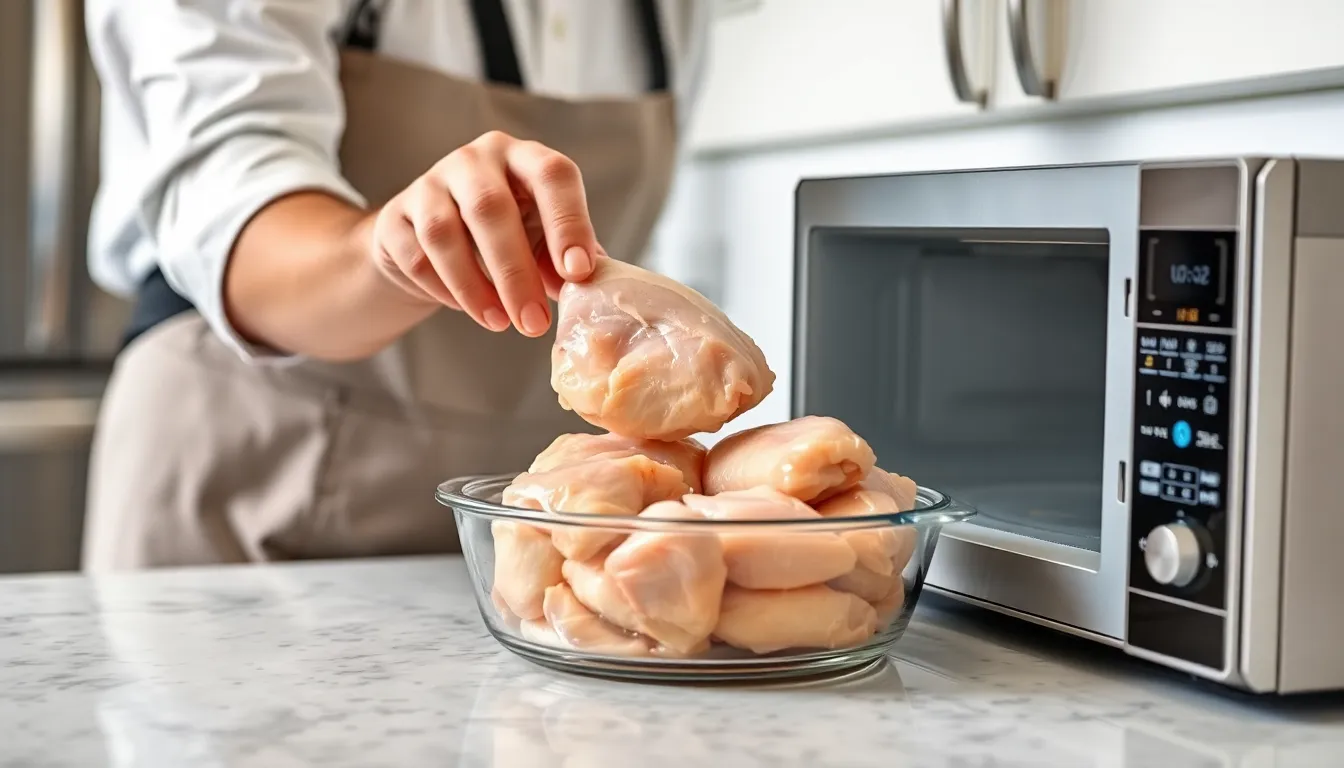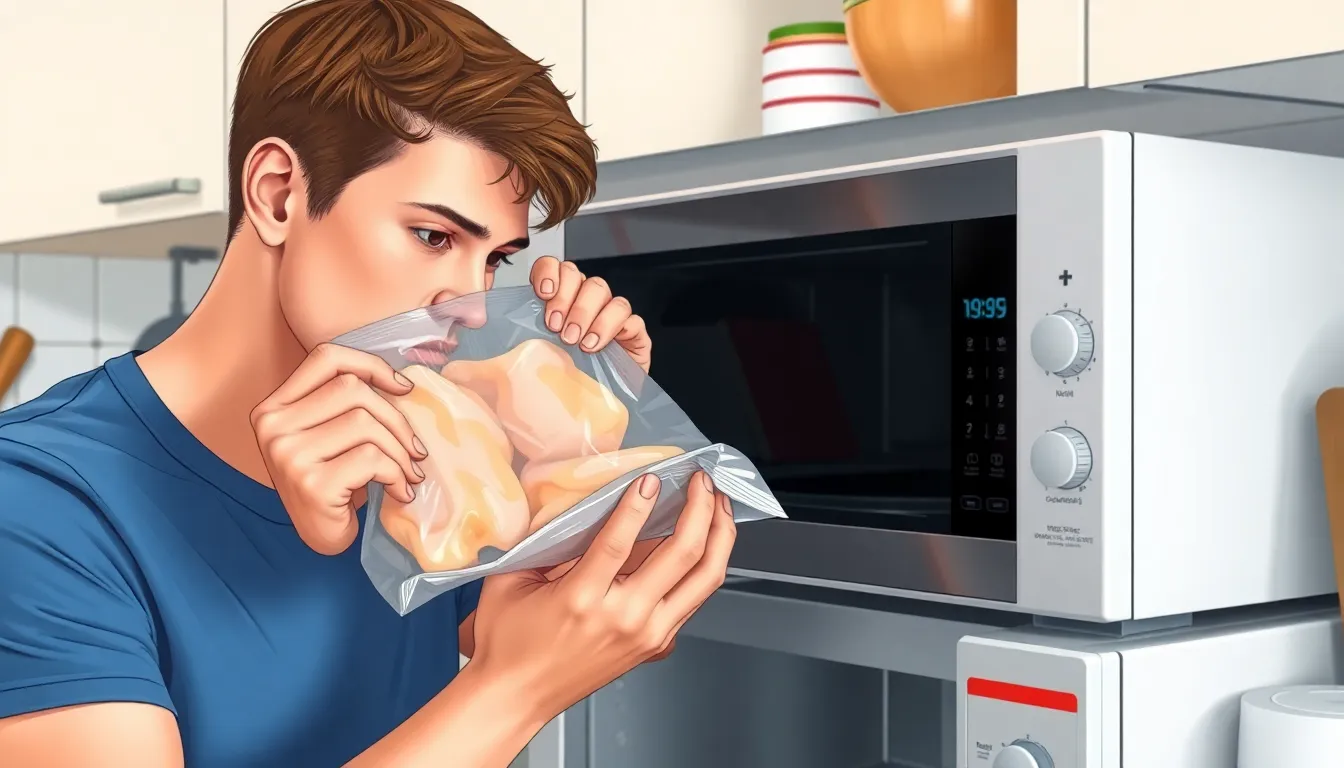Table of Contents
ToggleDefrosting chicken can feel like waiting for a snail to cross the road—slow and frustrating. But fear not! The microwave is here to save the day, transforming your frozen poultry into a juicy meal in no time. With just a few simple steps, you can go from frozen block to flavorful feast faster than you can say “What’s for dinner?”
Understanding The Importance Of Proper Defrosting
Proper defrosting of chicken plays a vital role in preventing foodborne illnesses. Bacteria can thrive on improperly thawed meat, leading to serious health risks. Microwaving provides a quick solution, but it requires attention to ensure safety during the process.
Defrosting chicken in the microwave allows for rapid preparation. This method significantly reduces waiting times, giving cooks flexibility when planning meals. Understanding the microwave’s defrost setting is key; it enables even thawing without beginning the cooking process.
Using the correct time settings matters. Thawing chicken for too long can lead to partially cooked areas, which fosters bacteria growth. Setting the microwave in short intervals helps maintain control and safe temperatures.
Checking the chicken’s temperature is essential once thawed. A safe internal temperature for cooked chicken is 165°F, but the thawed chicken should remain below 40°F until cooked. Regularly checking ensures safety.
Knowing how to defrost chicken reduces waste and enhances flavor. Frozen chicken that’s quickly thawed retains moisture and tenderness, resulting in a more tasty dish. Additionally, following microwave safety tips mitigates risks associated with cross-contamination and uneven cooking.
Timely and effective defrosting leads to a seamless cooking experience. Proper techniques not only ensure safety but also improve the quality of the finished meal. By understanding these aspects, cooks can confidently use the microwave for quick and efficient chicken defrosting.
Methods For Defrosting Chicken In The Microwave

Defrosting chicken in the microwave is quick and efficient. Follow these methods for optimal results.
Step-By-Step Guide
- Remove packaging from the chicken. Place the chicken in a microwave-safe dish.
- Use the microwave’s defrost setting. Select the appropriate time based on the weight of the chicken.
- Check the chicken after half the recommended time. Rotate it to ensure even thawing.
- Continue defrosting until it’s pliable but still cold. Aim for it to remain below 40°F.
- Cook the chicken immediately after defrosting. This prevents any bacterial growth.
Tips For Even Defrosting
- Cut the chicken into smaller pieces. Smaller portions defrost more evenly and quickly.
- Adjust the defrost time for various sizes. Thicker pieces may require longer intervals.
- Stop the microwave periodically. Check progress and rearrange the pieces if necessary.
- Use a thermometer to monitor temperature. Ensure the chicken remains safe during the process.
- Avoid leaving the chicken outside after defrosting. Immediate cooking maintains food safety.
Safety Considerations
Defrosting chicken in the microwave can pose safety risks if not done correctly. Understanding the precautions provides a safer cooking experience.
Avoiding Bacterial Growth
Proper defrosting techniques minimize the risk of bacterial growth. Temperatures above 40°F allow harmful bacteria to thrive. While defrosting, monitor chicken’s temperature closely. Use the microwave’s defrost setting to maintain safe temperature levels. Check the chicken halfway through cooking, ensuring it remains pliable and cold. Ideally, smaller pieces of chicken thaw more evenly and quickly. If defrost times vary, adjust based on the size of the chicken. Discard any chicken that shows signs of cooking, as this indicates that the meat surpassed safe temperature levels.
Cooking The Chicken After Defrosting
Cooking chicken immediately after defrosting eliminates potential safety hazards. When chicken sits at room temperature for extended periods, bacteria multiply rapidly. Aim for an internal temperature of 165°F to ensure thorough cooking. For uniform cooking, use a meat thermometer to check the thickest part of each piece. Remember to avoid refreezing partially cooked chicken. Instead, cook all pieces thoroughly and serve promptly. Utilizing these practices leads to safer and better-tasting chicken dishes.
Alternative Defrosting Methods
Defrosting chicken doesn’t always require a microwave. Cold water provides a quick and effective alternative. Seal the chicken in a leak-proof plastic bag, then immerse it in cold water, changing the water every 30 minutes. This method defrosts chicken at a safe rate, typically taking about one to three hours depending on the weight.
Refrigerating chicken offers a safer long-term option. When planning meals ahead, transferring the frozen chicken to the refrigerator ensures gradual thawing. It may take 24 hours for every five pounds, but this method prevents the risk of bacteria development. The chicken remains below 40°F during this process.
Cooking chicken from frozen is yet another viable alternative. For certain recipes, such as soups or stews, cooking chicken directly from frozen won’t pose safety issues. Adjust cooking times as needed, usually increasing the cooking duration by 50% or more.
Using a sous vide technique allows for precise and even thawing. Set the water temperature to a safe level, typically around 140°F, and immerse the sealed chicken. This method guarantees defrosting without any risk of raising the meat’s temperature into the danger zone.
Lastly, air frying provides an efficient way to defrost while cooking. Air fryers circulate hot air, thawing chicken while beginning the cooking process. Set the temperature low initially, gradually increasing it as the chicken thaws. This method saves time and minimizes the use of additional equipment.
Defrosting chicken in the microwave can be a game changer for busy cooks looking to save time. By following the right steps and keeping safety in mind, it’s possible to enjoy delicious meals without the long wait. Careful monitoring of the chicken’s temperature and using the microwave’s defrost setting ensures even thawing and minimizes the risk of bacteria growth.
It’s essential to cook the chicken immediately after defrosting to maintain food safety. With the right techniques, anyone can master this quick method and expand their culinary options. Whether it’s for a weeknight dinner or a last-minute meal, knowing how to defrost chicken safely and efficiently opens up a world of delicious possibilities.




